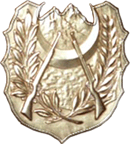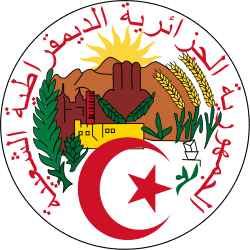People's National Army (Algeria)
| Armée Nationale Populaire الجيش الوطني الشعبي | |
|---|---|
|
ANP emblem | |
| Active |
1962 (Formerly the Armée de Libération Nationale) |
| Country |
|
| Branch | Army |
| Size | Total 423,500 incl paramilitary and reserve |
| Commanders | |
| Chief of Staff of the People's National Army | Ahmed Gaid Salah |
The Armée Nationale Populaire (ANP) (in Arabic : الجيش الوطني الشعبي) is the land force of the Military of Algeria. The Armée Nationale Populaire's equipment is provided by Russia, the People's Republic of China, and various other countries.
The Army include two armoured and three mechanised divisions (IISS Military Balance 2007), one of which is the 8th Armoured Division based at Ras El Ma, 90 kilometres from Sidi Bel Abbes,[1] in the 2nd Military Region. The division was formed from the 8th Armoured Brigade after 1988 (the 8th Armoured Brigade seems to have been formed in 1976). Another is the 40th Mechanised Infantry Division apparently based in the 3rd Military Region. The mission of the 40th Division is usually the protection of the Algerian-Moroccan frontier.[2] The IISS Military Balance 2013 named one of the other mechanised divisions as the 12th.
There is also French reporting of an airborne division formed in the early 1990s.[3] A division with five airborne regiments, seemingly similar to the French reporting, was listed in the IISS Military Balance for 2001-02 and 2006. However it was not list in the 2007 edition of the Military Balance.
Creation and development
After the end of the liberation war in June 1962, the first objective was to establish a logistics organization to meet the needs of the army - a structure, feed, clothe, care for and train . The directions of Stewardship, Hardware, Engineering and Health, Transport and Supply were the first to emerge. These directions, which came quickly join those of the staff of the Air Force, Navy and Education, at the Ministry, would form the backbone of the National People's Army. The bases of the general structure of the army were consolidated with the creation of the main directions, the establishment of an effective organization, the opening of schools and instruction centers and sending abroad trainees for different weapons and services.
Efforts to develop and modernize the ANP continued throughout the 1970s and 80s, at the organizational level, the formation of battalions and brigades. During the eighties, the army experienced a considerable growth. Thus, in 1986, a restructuring began, based primarily on the implementation of large units combining firepower and gradual movement, i.e. combat divisions, equipped with sophisticated weapons systems and other equipment necessary for the use and maintenance of these systems. This modernization was not just about the hardware, but included all organizational areas and combat. Thus was created the General Inspection of the PNA.
Military regions

Source: Library of Congress Country Study, 1993, 258-260
Algeria is divided into seven numbered military regions, each with headquarters located in a principal city or town. This system of territorial organization, adopted shortly after independence, grew out of the wartime wilaya structure and the postwar necessity of subduing antigovernment insurgencies that were based in the various regions. Regional commanders control and administer bases, logistics, and housing, as well as conscript training. Commanders of army divisions and brigades, air force installations, and naval forces report directly to the Ministry of National Defense and service chiefs of staff on operational matters.
During the 1980s, most of the army's combat units were concentrated in the 2nd Military Region (Oran) and to a lesser extent in the 3rd Military Region (Béchar). Chadli Bendjedid became head of the 2nd Military Region in 1964. Adjacent to Morocco, the 3rd Military Region straddles the main access routes from that country. It is also near the troubled Western Sahara, embracing territory previously claimed by Morocco. Much of the internal disorder and violence associated with economic distress and the Islamist movement has occurred in the 1st Military Region (Blida), which includes the capital of Algiers, and the 5th Military Region (Constantine). Army units have been strengthened in and near the cities where attacks against the government and security forces have occurred. Although regional commanders were originally all colonels, the commanders of the 1st Military Region (Mohamed Djenouhat) and the 5th Military Region (Abdelhamid Djouadi) were both promoted to major general in 1992. The two southeastern jurisdictions — the 4th Military Region (Ouargla) and 6th Military Region (Tamanrasset) — were sparsely populated tracts of desert where a limited number of combat troops carried out patrols and manned small outposts. The Ouargla region assumed a measure of strategic importance after relations with Libya soured, but the military's main activities there and in the 6th Military Region are the construction and planting projects undertaken by conscript forces. The 6th Military Region was created in 1975 to cover the south.[4]
President Bouteflika, as Minister of Defence, nominated new commanders for military regions in August 2004. (BICC) In 2010 there were a further series of changes. Président Bouteflika changed the commanders of three military regions, according to the presidential décrees published Wednesday 25 August in the Algerian Journal officiel. Général Mohand-Ameziane Si-Mohand was nominated to head the 3rd Military Region, le général Hassen Alaimia prend les commandes de la 4th Military Region et la 5e est désormais dirigée par le général Saïd Ziad.[5] These nominations took effect from 1 August, selon les mêmes décrets. President Bouteflika also named new deputy commanders in these military regions.
In 2013 a 7th Military Region was formed at Illizi in the south.[6]
Tanks
| Model | Type | Quantity | Notes |
|---|---|---|---|
| T-90SA+T-90MS | 3rd Generation MBT | 505 | The first batch of 185 was signed during 2009 and the second batch of 120 signed in 2011 for $470 million [7] + 200 received in 2015 [8] |
| T-72M/M1/M1M | 2nd Generation MBT | 1000 | 250 upgraded to M1M variantand 250 to AG the Ukrainian upgrade, it took place in the Algerian base BCL.[9] |
| T-62 | 2nd Generation MBT | 800 | [10] |
| T-55/AMV | 1st Generation MBT | 600 | |
| BMPT Terminator | Tank support combat vehicle[11] |
APCs/AFVs
| Model | Type | Quantity | Notes |
|---|---|---|---|
| BTR-80 | Armoured personnel carrier | 150[10] | |
| BTR-60 | Armoured personnel carrier | 250[10] | |
| FAHD | Armoured personnel carrier | 100[10] | |
| BMP-3 | Infantry fighting vehicle | 100[10] | |
| BMP-2 | Infantry fighting vehicle | 760[12] | Being upgraded to BMP-2 Berezhok configuration with 9M113 Kornet. |
| BMP-1 | Infantry fighting vehicle | 685[10] | Algeria signed a contract with Russia for modernization of 400 BMP-1s in 2006. |
| BRDM-2 | Armoured reconnaissance vehicle | 90[10] | 64 Modernized with to BDRM-2M standard armed with 9M113 Kornet missiles |
| AML 60 | Armoured reconnaissance vehicle | 44[10] | |
| Panhard M3 | Armoured personnel carrier | 55[10] | |
| TPz Fuchs | Armoured personnel carrier | 54 / 980 on order | In early 2011, 54 Fuchs worth $248 million were ordered from Rheinmetall. In 2014, 980 Fuchs were ordered as part of a €2.7 billion defence deal with Rheinmetall.[13] |
| Nimr | High mobility multipurpose vehicle | 3,000 | contract for the production of such armored vehicles with an annual turnout of 200 units for 15 years[14] |
| OT-64 SKOT | amphibious armored personnel carrier | 150[10] | [15] |
| Marauder | MRAP | [16] | |
Artillery
| Model | Type | Quantity | Notes |
|---|---|---|---|
| 2S3 Akatsiya | Self-Propelled Artillery | 30[10] | |
| 2S1 Gvozdika | Self-Propelled Artillery | 140[10] | |
| PLZ-45 | Self-Propelled Artillery | 50 [17] | |
| ML-20 | Howitzer | 20[10] | |
| M-46 | Howitzer | 10[10] | |
| D-30 | Howitzer | 160[10] | |
| D-44 | Howitzer | 80 | |
| 160mm Mortar M1943 | Mortar | 60[10] | |
| 120-PM-43 mortar | Mortar | 120[10] | |
| 82-PM-37 mortar | Mortar | 150[10] |
MRLs
| Model | Type | Quantity | Notes |
|---|---|---|---|
| BM-30 Smerch | Multiple rocket launcher | 50[10] | |
| BM-24 | Multiple rocket launcher | 30[10] | |
| BM-14-16 | Multiple rocket launcher | 48[10] | |
| BM-21 Grad | Multiple rocket launcher | 48[10] |
Air Defense Systems
| Model | Type | Quantity | Notes |
|---|---|---|---|
| S-75 Dvina | Surface-to-air missile | 6 batteries | |
| S-300PMU-2 | Surface-to-air missile | 8 batteries | 8 batt. of S-300PMU-2 were ordered,[18][19] |
| S-125 Neva/Pechora | Surface-to-air missile | 5 batteries | |
| 2K12 Kub | Surface-to-air missile | 40 batteries | |
| 9K33 Osa | Surface-to-air missile | 48 Systems[10] | |
| Pantsir-S1 | Surface-to-air missile | 76 Systems | [20] +38 received in 2013[21][22][23] |
| 9K31 Strela-1 | Surface-to-air missile | 20 launchers[10] | |
| 9K35 Strela-10 | Surface-to-air missile | 32 launchers | |
| ZSU-57-2 | Self-propelled anti-aircraft gun | 20 | |
| ZSU-23-4 | Self-propelled anti-aircraft gun | 225 | |
| S-60 | Anti-aircraft gun | 70 | |
| 61-K | Anti-aircraft gun | 145 | |
| ZU-23-2 | Anti-aircraft gun | 50 | |
| Antey-2500 | Surface-to-air missile | [24] | |
| S-400 (missile) | Surface-to-air missile | 2 batteries[25] | |
| Buk M-2 | Surface-to-air missile | 48 batteries[25] |
Future Acquisitions
An agreement with Rheinmetall for 980 Fuchs armoured personnel carriers over 10 years was signed in 2014,[13] on top of 54 that were already ordered[26]
References
- ↑ Le Soir Algerie, Voyage au cœur de la 8e Division blindée, 1997.
- ↑ http://www.algeria-watch.org/pdf/pdf_en/forces_repression.pdf. http://www.algeria-watch.org/fr/mrv/mrvmili/tigha_patriotes.htm
- ↑ Centre Francais de recherche sur la reseignement, Bulletin de documentation 5, accessed January 2014.
- ↑ http://www.lematindz.net/news/6233-lalgerie-est-elle-en-situation-de-guerre.html
- ↑ Vaste mouvement dans les structures des Régions Militaires, 26 August 2010
- ↑ http://www.lexpressiondz.com/actualite/177692-l-algerie-prevoit-une-7e-region-militaire.html
- ↑ http://www.vestnik-rm.ru/news-4-7606.htm
- ↑ http://www.janes.com/article/56786/more-t-90-tanks-bound-for-algeria
- ↑ http://vpk.name/news/62557_s_pricelom_na_staryih_partnerov.html
- 1 2 3 4 5 6 7 8 9 10 11 12 13 14 15 16 17 18 19 20 21 22 23 24 International Institute for Security Studies (February 11, 2015). The Military Balance 2015 (2015 ed.). Routledge. pp. 319–321. ISBN 1857437667.
- ↑ http://secret-difa3.blogspot.com/2013/08/le-bmpt-terminator-lessai-en-algerie.html
- ↑ http://armstrade.org/files/obrazecglava4.pdf
- 1 2 Rheinmetall to sign 2.7 billion euro deal with Algerian military for 980 Fuchs vehicles
- ↑ http://www.lbcgroup.tv/news/75020/international-defense-exhibition-and-conference-id
- ↑ http://www.armyrecognition.com/algeria/algerian_army_algeria_land_forces_pictures_modern_army_military_equipment_vehicle_pictures_descripti.html/
- ↑ http://www.zakon.kz/4796994-ministr-oborony-rk-vstretil-inostrannye.html=
- ↑ SIPRI Arms Transfers Database. Retrieved 17 December 2015.
- ↑ In 2006 it was thought that the capabilities of the command would be boosted by the delivery from Russia of eight S-300PMU2 Favorit air defence missile systems, ordered as part of the package of arms deals with Russia announced in 2006 as part of a USD7.5 billion arms package.In fact the first battalion of S-300 series SAMs ordered by Algeria was delivered in 2008 however the rest of the deal had been frozen.
- ↑
- ↑ "Newly-supplied Russian Pantsyr-1 anti-air missile used to down Turkish warplane". DEBKAfile. 24 June 2012. Retrieved 24 June 2012.
- ↑ http://tass.ru/armiya-i-opk/1884007
- ↑ http://www.rg.ru/2015/04/07/pancir-site-anons.html
- ↑ http://lenta.ru/news/2015/04/07/pantsir/
- ↑ http://www.kommersant.ru/doc/2831626
- 1 2 . http://armstrade.org/files/obrazecglava4.pdf
- ↑ https://www.defenseindustrydaily.com/algerian-arms-deal-brings-russia-75-billion-gas-market-leverage-02024/

